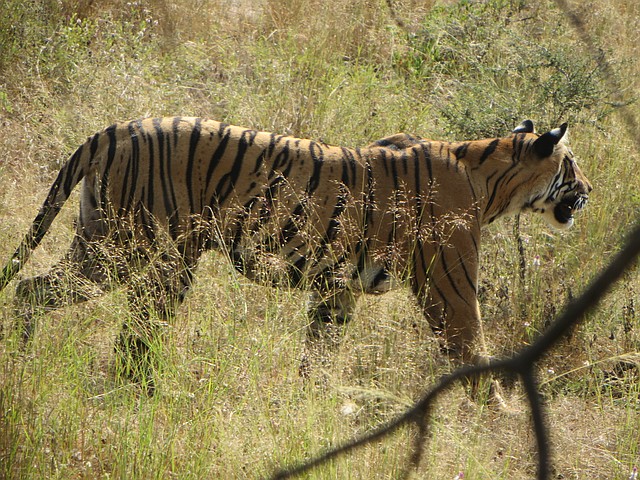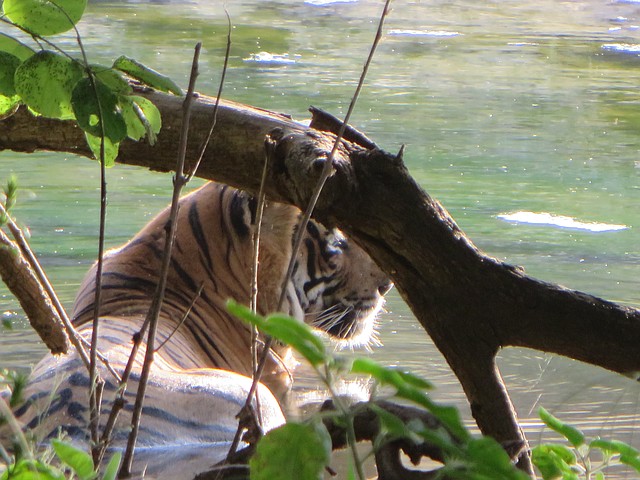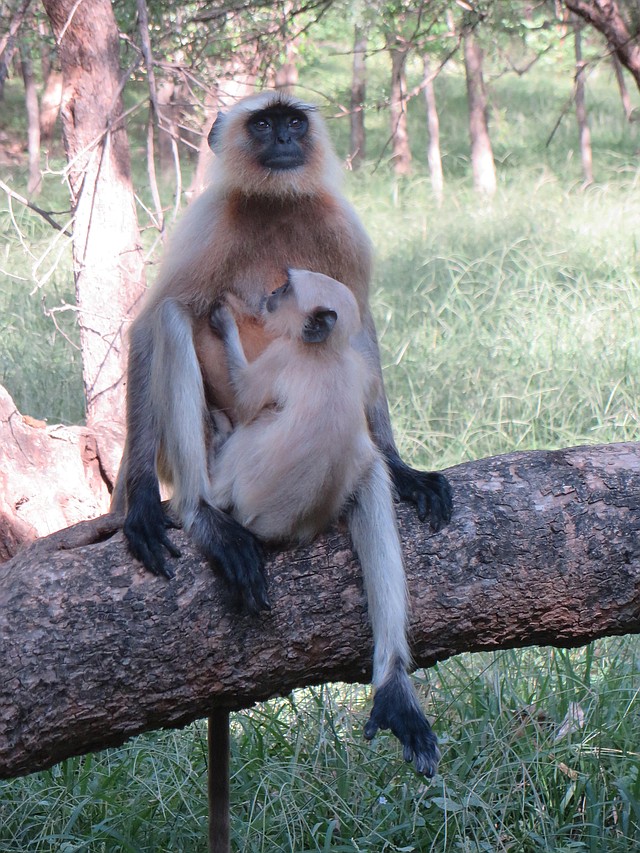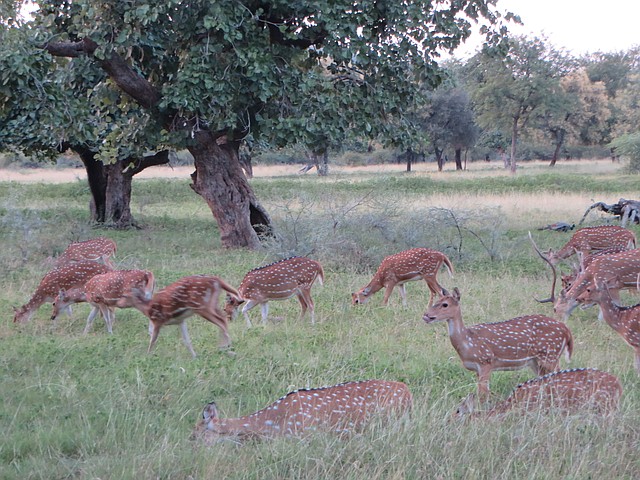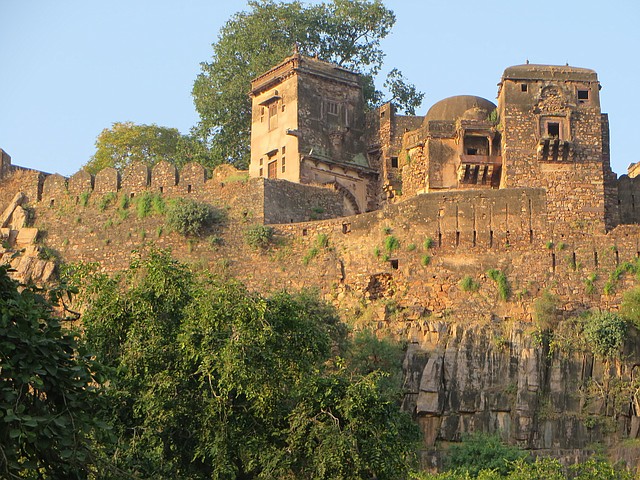Tigers and monkeys and mongoose, oh my!
November 24, 2014 at 6:00 a.m.
Svelte and graceful, the lithe tigress made her way through the tall grass, her movements barely making a whisper. She had come to check on her three cubs, who were playfully engaged in some sort of comical roll-over game with one another. As soon as her presence registered, however, the cubs stopped their antics and began to dutifully follow their mother. We watched in awe and wonderment as this elegant creature in all her glorious stripes crossed the road in front of our safari jeep. Though we knew the tigress was fully aware of us, she never glanced our away, preferring to remain aloof and distant. The cubs trailed after their mother, one at a time, closely adhering to her path. Two of the trio made it to the other side; the third became wary and then balked, choosing to retreat back into the grass. It only took a moment before the tigress realized the situation and quickly headed back over the road to retrieve her skittish young’un. It was a privileged moment for our group and we reveled in the good fortune and timing that had allowed us to witness this amazing scene at Ranthambore National Park in northern India.
Once the former hunting grounds of the Maharajas of Jaipur, Ranthambore is now a renowned national park and wildlife attraction. Covering over 150 square miles and bounded by rivers, the park is a veritable haven for animals, birds and reptiles. Its dense, tropical dry forest with open grassy meadows and numerous lakes and streams make it an ideal milieu for such creatures as monkeys, leopards, hyenas, jackals, deer, antelope, wild boar, mongoose, crocodiles, iguana, snakes, bats and more.
The most famous resident, however, is the Bengal tiger. Currently, there are nearly 60 of these majestic jungle cats living within Ranthambore, thanks to Project Tiger’s conservation efforts. Each has its own territory which it marks and guards fiercely. These areas contain large amounts of prey animals, providing plentiful food options. The tigers are individually named and have unique reputations and legends that precede their lineages. There’s Machali, for example, the now toothless and old, though still regal tigress queen, whose fight with a fourteen-foot-long crocodile years ago created history when it was filmed and recorded. The event made her the star of the tiger world and the subject of books and movies. And then there’s Romeo, the lover who yearns to attract the attention of the winsome Laila. Unfortunately, this enchantress often spurns poor Romeo’s advances, preferring to flirt and fraternize with others. Sultan, a handsome, three-year-old male, graced us with his presence, as he ambled down the road to a nearby watering hole. There, in the shade of a tree, he sprawled languidly, taking in his surroundings with a kingly air. He was a sight to behold and we ogled and gawked at him like star struck fans in the midst of a celebrity.
Though the tigers are certainly the main draw at Ranthambore, the other creatures who make their home in the park are equally fascinating to observe. The Langur monkeys with their long tails and slender bodies are consummate entertainers, flying from branch to branch among the treetops like Olympic gymnasts. We espied a mother nursing her baby, groups standing in military style attention and even a brave soul who jumped on the back of our jeep and curiously peered at us.
Other unforgettable images included herds of Sambar deer running nimbly through the woods, a sleek mongoose intently hunting for food, an iguana poking its head out of a hole in a tree, a stunning Nilgai or “blue bull” antelope playing hide-and-seek with us between trees and a large croc lazily sunning itself in the river. Peacocks and their hens wandered about, making their almost human-like screams, while an assortment of flamingos, pelicans, hornbills, kingfishers and other resplendent birds added vibrant color to the scene.
The environment itself is also something to behold. Enormous banyan trees with expansive limbs and leathery leaves sprawl across the landscape, along with numerous ruins that lay scattered about the jungle. Old crumbling walls and the remains of once glorious pavilions and battlements from the impressive 10th century Ranthambore Fort provide testament to the region’s glorious past.
Those who visit the park can only do so via safari. Safaris are offered twice daily; once in the early morning and then again later in the afternoon. These time periods allow for optimal wildlife observation, whereas in the heat of the day, most animals are hard to spot as they are usually napping under cover. During a safari adventure, you will be accompanied by a driver and a naturalist guide whose job it is to spot wildlife and educate participants about animal behavior, as well as about the vegetation and the history of the area. Naturalists point out signs of various creatures such as paw prints on the road and depressions in the grass. They also help identify the sounds that echo within the forest environment. When the monkeys and birds, for example, start increasing their “chatter” in a frenzied fashion, it’s most likely because a tiger has entered the vicinity. Their warning calls are helpful to the guides and drivers in locating the renowned jungle cats.
It’s true that Africa has garnered a reputation for being a safari-lover’s paradise. The region has a cornerstone on the market and it is the place where most folks head when they wish to see prized animals in their natural habitat. India, however, holds its own as a wildlife enthusiast’s and photographer’s dream destination. Add in an exotic culture and magnificent ancient wonders and you have a country that presents travelers with a unique and memorable travel experience.
Deborah Stone is a travel and lifestyle writer, who explores the globe in search of unique destinations and experiences to share with her readers. She’s an avid adventurer who welcomes new opportunities to increase awareness and enthusiasm for travel and cross-cultural connections. Her stories appear in a number of publications as well as on various travel websites. Additionally, she can be frequently be heard dishing travel with the hosts of the NPR-affiliated and AARP produced talk radio show, “2 Boomer Babes.” Deborah is a longtime Seattle area resident, who currently resides in Santa Fe, New Mexico.

